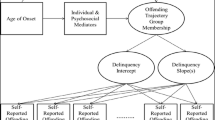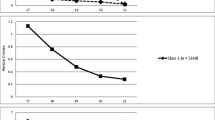Abstract
A number of criminological theories make either implicit or explicit predictions about the empirical relationship between prior and future offending behavior. Some argue that time-stable characteristics such as criminal propensity should account for any positive correlation between past and future criminal behavior for all individuals. Others contend that the positive association between offending behavior at different points in time are partly causal and partly spurious. Still others anticipate that different patterns will emerge for different groups (distinguished by their ciminal propensity) of individuals. Using a longitudinal data set comprised of 848 training school releasees, we test various hypotheses emanating from these different theoretical perspectives. The results indicate that (1) both stability and change have causal implications for one's offending behavior and (2) with but one exception, these effects do not vary between high and low criminal propensity groups.
Similar content being viewed by others
References
Agnew, R. (1992). Foundation for a general strain theory of crime and delinquency.Criminology 30: 47–87.
Akers, R. (1985).Deviant Behavior, Wadsworth, Belmont, CA.
Barnett, A., and Lofaso, A. J. (1985). Selective incapacitation and the Philadelphia cohort data.J. Quant. Criminol. 1: 3–36.
Barnett, A., Blumstein, A., and Farrington, D. P. (1989). A prospective test of a criminal career model.Criminology 27: 373–385.
Barnett, A., Blumstein, A., Cohen, J., and Farrington, D. P. (1992). Not all criminal career models are equally valid.Criminology 30: 133–140.
Blumstein, A., Cohen, J., Roth, J., and Visher, C. (1986).Criminal Careers and “Career Criminals,” National Academy Press, Washington, DC.
Blumstein, A., Cohen, J., and Farrington, D. P. (1988). Criminal career research: Its value for criminology.Criminology 26: 1–35.
Cameron, A. C., and Trivedi, P. K. (1986). Econometric models based on count data: Comparisons and applications of some estimators and tests.J. Appl. Econometr. 1: 29–53.
Clogg, C. C., Petkova, E., and Haritou, A. (1995). Statistical methods for comparing regression coefficients between models.Am. J. Sociol. 100(5): 1261–1293.
Dean, C. W., Brame, R., and Piquero, A. R. (1996). Criminal propensities, discrete groups of offenders, and persistence in crime.Criminology 34: 547–574.
Farrington, D. P., and West, D. J. (1995). The effects of marriage, separation, and children on offending by adult males. In Blau, Z. S., and Hagan, J. (eds.),Current Perspectives on Aging and the Life Cycle. Vol. 4: Delinquency and Disrepute in the Life Course: Contextual and Dynamic Analyses. JAI Press, Greenwich, CT.
Farrington, D., Loeber, R., Elliott, D., Hawkins, J. D., Kandel, D., Klein, M., McCord, J., Rowe, D., and Tremblay, R. (1990). Advancing knowledge about the onset of delinquency and crime. In Lahey, B., and Kazdin, A. (eds.),Advances in Clinical Child Psychology, Plenum Press, New York.
Gottfredson, M., and Hirschi, T. (1986). The true value of lambda would appear to be zero: An essay on career criminals, criminal careers, selective incapacitation, cohort studies, and related topics.Criminology 24: 213–234.
Gottfredson, M., and Hirschi, T. (1988). Science, public policy, and the career paradigm.Criminology 26: 37–55.
Gottfredson, M., and Hirschi, T. (1990).A General Theory of Crime, Stanford University Press, Stanford, CA.
Greene, W. (1995).LIMDEP Version 7.0 User's Manual, Econometrics Software, Belport, NY.
Hausman, J., Hall, B. H., and Griliches, Z. (1984). Econometric models for count data with an application to the patents-R&D relationship.Econometrica 52(4): 909–938.
Hirschi, T. (1969).Causes of Delinquency, University of California Press, Berkeley.
Hirschi, T., and Gottfredson, M. (1995). Control theory and the life-course perspective.Stud. Crime Crime Prevent. Biann. Rev. 4: 131–142.
Horney, J., Osgood, D. W., and Marshall, I. (1995). Criminal careers in the short term: Intraindividual variability in crime and its relation to local life circumstances.Am. Sociol. Rev. 60: 655–673.
Hsiao, C. (1986).The Analysis of Panel Data, Cambridge University Press, New York.
Land, K. C. (1992). Models of career criminals: Some suggestions for moving beyond the current debate.Criminology 30: 149–155.
Land, K. C., and Nagin, D. S. (1996). Micro-models of criminal careers: A synthesis of the criminal careers and life course approaches via semiparametric mixed Poisson regression models, with empirical applications.J. Quant. Criminol. 12(1): 163–191.
Land, K. C., McCall, P. L., and Nagin, D. S. (1996). A comparison of Poisson, negative binomial, and semiparametric mixed Poisson regression models, with empirical applications to criminal careers data.Sociol. Methods Res. 24: 387–442.
Laub, J., and Sampson, R. (1993). Turning points in the life course: Why change matters to the study of crime.Criminology 31: 301–326.
LeBlanc, M., and Frechette, M. (1989).Male Criminal Activity from Childhood Through Youth, Springer-Verlag, New York.
Lemert, E. (1951).Social Pathology, McGraw-Hill, New York.
Lemert, E. (1972).Human Deviance, Social Problems, and Social Control, Prentice-Hall, Englewood Cliffs, NJ.
Loeber, R., and LeBlanc, M. (1990). Toward a developmental criminology. In Tonry, M., and Morris, N. (eds.),Crime and Justice: An Annual Review of Research, Vol. 12, University of Chicago Press, Chicago, IL.
Moffitt, T. (1993). Adolescent-limited and life-course persistent antisocial behavior: A developmental taxonomy.Psychol. Rev. 100: 674–701.
Moffitt, T. (1994). Natural histories of delinquency. In Weitekamp, E., and Hans-Jurgen, K. (eds.),Cross-National Longitudinal Research on Human Development and Criminal Behavior, Kluwer Academic, Dordrecht, The Netherlands.
Moffitt, T., Caspi, A., Dickson, D., Silva, P., and Stanton, W. (1996). Childhood-onset vs. adolescent-onset antisocial conduct problems in males: Natural history from ages 3 to 18 years.Dev. Psychopathol. 8: 399–424.
Nagin, D. S., and Farrington, D. (1992a). The stability of criminal potential from childhood to adulthood.Criminology 30: 235–260.
Nagin, D. S., and Farrington, D. (1992b). The onset and persistence of offending.Criminology 30: 501–523.
Nagin, D., and Land, K. (1993). Age, criminal careers, and population heterogeneity: Specification and estimation of a nonparametric, mixed Poisson model.Criminology 31: 327–362.
Nagin, D., and Paternoster, R. (1991). On the relationship of past and future participation in delinquency.Criminology 29: 163–190.
Nagin, D., and Paternoster, R. (1993). Enduring individual differences and rational choice theories of crime.Law Soc. Rev. 27: 467–496.
Nagin, D., and Paternoster, R. (1994). Personal capital and social control: The deterrence implications of a theory of individual differences in criminal offending.Criminology 32: 581–606.
Nagin, D., Farrington, D., and Moffitt, T. (1995). Life-course trajectories of different types of offenders.Criminology 33: 111–139.
Osgood, D. W., and Rowe, D. C. (1994). Bridging criminal careers, theory, and policy through latent variable models of individual offending.Criminology 32: 517–554.
Paternoster, R., and Brame, R. (1997). Multiple routes to delinquency? A test of developmental and general theories of crime.Criminology 35: 49–84.
Patterson, G. (1993). Orderly change in a stable world: The antisocial trait as a chimera.J. Consult. Clin. Psychol. 61: 911–919.
Patterson, G., and Yoerger, K. (1993). Developmental models for delinquent behavior. In Hodgins, S. (ed.),Mental Disorder and Crime, Sage, Newbury Park, CA.
Patterson, G., DeBaryshe, B., and Ramsey, E. (1989). A developmental perspective on anti-social behavior.Am. Psychol. 44: 329–335.
Patterson, G., Crosby, L., and Vuchinich, S. (1992). Predicting risk for early police arrest.J. Quant. Criminol. 8: 335–355.
Sampson, R., and Laub, J. (1993).Crime in the Making: Pathways and Turning Points Through Life, Harvard University Press, Cambridge, MA.
Sampson, R., and Laub, J. (1995). Understanding variability in lives through time: Contributions of life-course criminology.Stud. Crime Crime Prev. Biann. Rev. 4: 143–158.
SAS Institute (1990).SAS Language, SAS Institute, Cary, NC.
Simons, R., Wu, C.-I., Conger, R., and Lorenz, F. (1994). Two routes to delinquency: Differences between early and late starters in the impact of parenting and deviant peers.Criminology 32: 247–275.
Stattin, H., and Magnusson, D. (1995). Onset of official delinquency: Its co-occurrence in time with educational, behavioral, and interpersonal problems.Br. J. Criminol. 35: 417–449.
Thornberry, T. (1987). Towards an interactional theory of delinquency.Criminology 25: 863–891.
Tittle, C. R. (1995).Control Balance: Toward a General Theory of Deviance, Westview Press, Boulder, CO.
Weisz, J., Walter, B., Weiss, B., Fernandez, G., and Mikow, V. (1990). Arrests among emotionally disturbed violent and assaultive individuals following minimal vs. lengthy intervention through North Carolina's Willie M Program.J. Consult. Clin. Psychol. 58: 72–78.
Wilson, J., and Herrnstein, R. (1985).Crime and Human Nature, Simon and Schuster, New York.
Author information
Authors and Affiliations
Rights and permissions
About this article
Cite this article
Paternoster, R., Dean, C.W., Piquero, A. et al. Generality, continuity, and change in offending. J Quant Criminol 13, 231–266 (1997). https://doi.org/10.1007/BF02221092
Issue Date:
DOI: https://doi.org/10.1007/BF02221092




